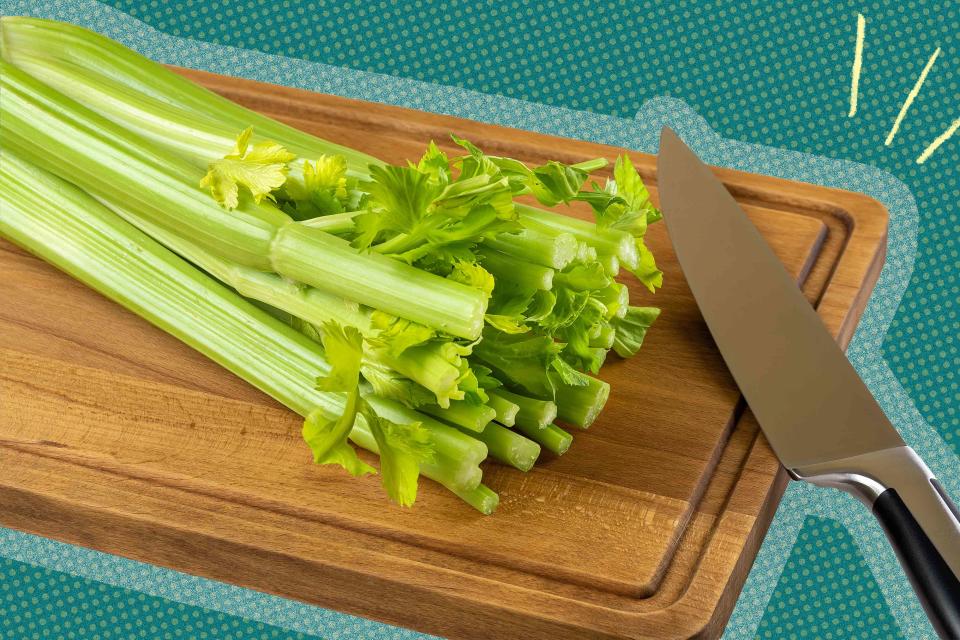The Only Way You Should Store Celery, According to a Food Expert
An expert’s tip for bidding farewell to rotten stalks.

Simply Recipes / Photo Illustration by Wanda Abraham / Getty Images
There’s something so enticing about a crisp piece of celery. It has so much potential as a satisfying crunchy snack, but I particularly love it as a snappy addition to homemade chicken salad. That’s why I hate opening the veggie drawer in my fridge and finding that my once-crunchy stalks have gone limp and soggy.
What Causes Celery To Rot Faster
When I shop for celery, I look for one that is pale green and crisp with the ribs packed tightly together. The leaves on the stalks should look fresh and there should be no bruises or discoloration on the ribs.
Celery can quickly go bad when it dries out and there isn’t enough humidity to keep this water-intensive vegetable crisp.
“When celery is at the end of its shelf life, you will find that those firm, green celery stalks you purchased are now whitish in color, soft, and bendable,” says registered dietitian nutritionist Melissa Prest, DCN, RDN, a spokesperson, for the Academy of Nutrition and Dietetics. “If it is slimy or mushy, it is well past its shelf life and should be thrown away.”

The Best Way To Store Celery
Proper storage is key to keeping celery at its best. Don’t store it with apples, avocados, pears, or other items that release ethylene, a gas emitted by some fruits and vegetables that can cause sensitive produce to ripen faster.
Never keep celery in the plastic bag or wrap from the store, since that traps the ethylene gas it releases and causes the stalks to spoil faster. Instead, here’s a quick trick I learned that extends the life of my celery: Wrap it in aluminum.
“It's best to store celery in a crisper drawer in the fridge where it can last up to two weeks,” says Prest. “You will want to remove the plastic wrapping before storing it and wrap it in a sheet of foil before placing it in the fridge.”
The foil helps the celery stalks maintain moisture. If you have the time and want to put in more effort on the food preservation front, there’s also a more elaborate way to keep celery fresh that involves a bit of prep.
“For best results, keep celery in the fridge for longer by pre-cutting it and placing it vertically in a shallow amount of water,” says Caroline Thomason, RD CDCES, a Northern Virginia-based dietitian. “The stalks will soak up the added water and stay fresh longer.”

Is It Safe To Eat Iffy Celery?
As long as the celery isn’t slimy, moldy, mushy, or discolored, you can still use it in recipes for soups, stews, and stir-fries.
“In fact, using celery and other vegetables that are nearing the end of their shelf-life as a base for vegetable broth or stock is a great way to reduce food waste,” says Prest. To help soggy celery perk up, she suggests washing it, cutting it into strips, then soaking it in a container of ice water for about 30 minutes.
You can also keep celery out of the compost pile by freezing it. First, blanch it by adding it to a pot of boiling water for a couple of minutes, then plunge it into an ice bath for a couple more minutes to stop the cooking. Dry the celery thoroughly by draining it, then patting it dry, says Prest.
Celery prepared this way can keep for a year or more in the freezer when kept in a freezer-safe bag or container. Because celery can get mushy when it thaws, I like tossing it frozen into a soup or stew as it cooks. It’s missing that great crispness if you try tossing it in a salad. When you need celery’s signature crunch, choose fresh.
Read the original article on Simply Recipes.


